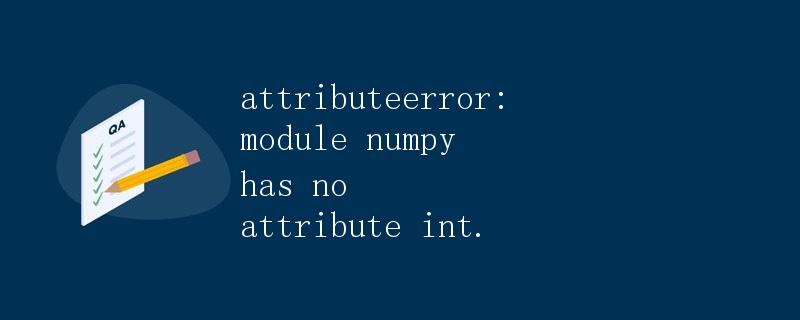AttributeError: module ‘numpy’ has no attribute ‘int’

在使用Python的数据科学和数学计算中,经常会用到一个非常强大的库——NumPy。NumPy提供了许多用于数组操作和数学计算的函数和方法,使得处理大规模数据变得更加高效和便捷。然而,有时候在使用NumPy时会遇到一些错误,比如“AttributeError: module ‘numpy’ has no attribute ‘int’”。
错误背景
在Python中,数据类型有着非常丰富的种类,不仅有基本的数据类型(例如整数、浮点数、字符串等),还有一些特殊的数据类型(例如集合、元组、字典等)。在NumPy中,数组是最为常见和重要的数据类型,它可以用来表示向量、矩阵等多维数据结构。
在NumPy中,数组的元素类型是固定的,通常是整数、浮点数或者其他数据类型。为了方便表示数组的元素类型,NumPy提供了一些常用的数据类型的别名,例如np.int表示整数类型,np.float表示浮点数类型。然而,有时候我们可能会误将np(NumPy库)当成一个类似Python内置类型的对象,导致错误的调用int属性,从而触发“AttributeError: module ‘numpy’ has no attribute ‘int’”错误。
解决方法
要解决“AttributeError: module ‘numpy’ has no attribute ‘int’”错误,我们需要明确理解NumPy中的数据类型和属性。在NumPy中,数据类型是通过np.dtype对象来定义和表示的,而不是通过np.int这样的属性。因此,当我们需要使用NumPy的整数类型时,应该调用np.dtype(np.int)来表示整数类型,而不是直接调用np.int属性。
下面通过一个示例代码来演示如何正确地定义和使用NumPy的整数类型:
import numpy as np
# 定义一个包含整数类型数据的NumPy数组
arr = np.array([1, 2, 3, 4, 5], dtype=np.dtype(np.int))
# 打印数组的数据类型
print(arr.dtype)
上述代码中,我们首先导入NumPy库,并定义了一个包含整数类型数据的NumPy数组arr。在定义数组时,我们通过dtype=np.dtype(np.int)指定了数组的数据类型为整数类型。最后,我们打印了数组arr的数据类型,输出如下:
int32
从输出可以看出,数组arr的数据类型为int32,即32位整数类型。这表明我们成功地定义和使用了NumPy的整数类型,避免了“AttributeError: module ‘numpy’ has no attribute ‘int’”错误。
总结
在使用NumPy库时,避免出现“AttributeError: module ‘numpy’ has no attribute ‘int’”错误非常重要。我们应该正确理解NumPy的数据类型和属性,遵循NumPy的规范和约定,避免误用属性或方法导致错误。通过本文的介绍和示例代码,相信读者对解决“AttributeError: module ‘numpy’ has no attribute ‘int’”错误有了更清晰的认识和理解,希月对读者有所帮助。
 极客笔记
极客笔记